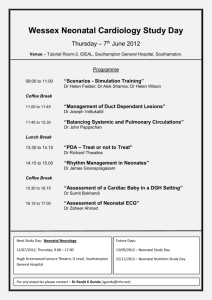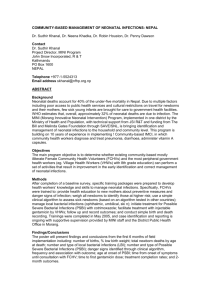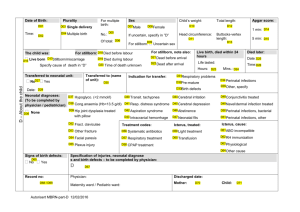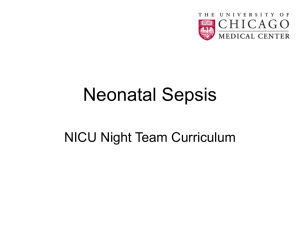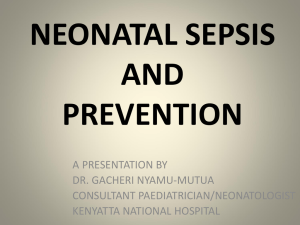Lecture 4 د. نعمان نافع الحمداني Dr Numan Nafie Hameed Neonatal
advertisement
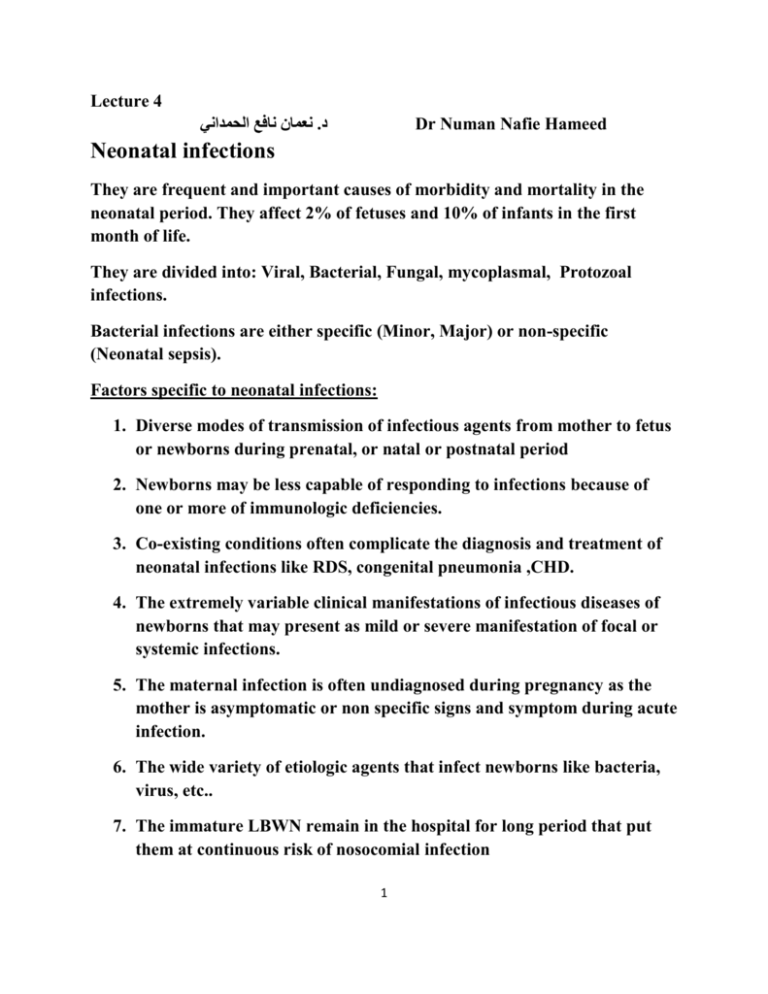
Lecture 4 نعمان نافع الحمداني.د Dr Numan Nafie Hameed Neonatal infections They are frequent and important causes of morbidity and mortality in the neonatal period. They affect 2% of fetuses and 10% of infants in the first month of life. They are divided into: Viral, Bacterial, Fungal, mycoplasmal, Protozoal infections. Bacterial infections are either specific (Minor, Major) or non-specific (Neonatal sepsis). Factors specific to neonatal infections: 1. Diverse modes of transmission of infectious agents from mother to fetus or newborns during prenatal, or natal or postnatal period 2. Newborns may be less capable of responding to infections because of one or more of immunologic deficiencies. 3. Co-existing conditions often complicate the diagnosis and treatment of neonatal infections like RDS, congenital pneumonia ,CHD. 4. The extremely variable clinical manifestations of infectious diseases of newborns that may present as mild or severe manifestation of focal or systemic infections. 5. The maternal infection is often undiagnosed during pregnancy as the mother is asymptomatic or non specific signs and symptom during acute infection. 6. The wide variety of etiologic agents that infect newborns like bacteria, virus, etc.. 7. The immature LBWN remain in the hospital for long period that put them at continuous risk of nosocomial infection 1 Factors that increase the risk of infection: Prolonged rupture of membranes or leaking liquor Chorioamnionitis Maternal fever Being preterm . < I kg increase the risk by 10 times Portals of entry of Neonatal infections: 1. Intra-uterine (Tran-placental): a. maternal blood stream b. ascending infection due prolonged rupture of membranes c. prolonged labor and repeated PV exam. 2. During passage of the neonate through infected birth canal: 3. Postnatally acquired (Nosocomial): Viral infections: Vertically transmitted viral infections can cause severe or fatal diseases, can be divided into: Congenital: transmitted to the fetus in utero and can cause symptoms in utero which may be diagnosed by US. (TORCHES), include toxoplasmosis, Rubella, CMV, Herpes simplex. It also include syphilis, HIV, and Hepatitis Perinatal: tramsmitted to NB natally or postnatally including breast feeding, and may not become apparent until many days or weeks after birth. Bacterial infections: specific( major, minor) non-specific (Neonatal sepsis) Neonatal sepsis (NS): Early onset Neonatal sepsis (EONS): Birth–7 days 2 Late Onset Neonatal Sepsis: (LONS): 8- 28 days Nosocomial Neonatal sepsis: 8 – 90 days or discharge Early onset Neonatal sepsis (EONS): Birth – 7 days. 1-4 cases / 1000 live births. They usually begin in utero , preceded by maternal genito-urinary infections by GBS, E coli, klebsiella. Risk Factors: Vaginal colonization with GBS, Prolonged rupture of membranes > 18 hours , Chorioamnionitis, Fetal tachycardia , Preterm infants and LBWN , Maternal fever and leukocytosis , Black race and male sex. Clinical presentation: EONS can present as either Asymptomatic bacteremia or Generalized sepsis or Pneumonia+- meningitis. EONS mostly affect preterm, and present with non-specific signs and symptoms like poor feeding, granting, pallor, apnea, lethargy, hypothermia, abnormal cry, vomiting and ileus. Later EONS can present with overwhelming multi-organ system disease as respiratory failure, shock, meningitis, DIC , acute tubular necrosis. It is difficult to differentiate EONS from RDS in preterm so we give empiric antibiotics to both diseases. Differential diagnosis: TTN, meconium aspiration, ICH(IVH), Torches, CHD especially PDA. Less common – bowel obstruction, NEC, inborn error of metabolism Evaluation of Early neonatal sepsis: • CBP Hb , WBC, differential, blood film, platelet count, (PT,PTT,INR in ill) • Serial CRP titers every 12 hours • Blood C&S aerobic and anerobic 3 • Lumbar puncture – CSF exam. General , gram stain, culture, simultaneous blood sugar. • C-X Ray to DX pneumonia , RDS. Echocardio may be of benefit in severely ill cyanotic NB for pulmonary hypertension • Blood gases • Monitor BP,UOP • IL 6(interleukin6), IL 8, TNF(tumor necrosis factor • Cell surface markers CD 11b, CD 64 • Molecular biology technique - future Treatment of Early neonatal sepsis: • Supportive: IVF,NAHCO3, O2, incubator care, monitoring, feeding, mechanical ventilation, surfactant for pneumonia and RDS, inhaled NO, anticonvulsants, ECHO study for heart, adjuvant immunotherapy, ECMO. • Specific: Combination of antibiotics like ampicillin and gentamicin for 10-14 days , extend to 21 in meningitis, waiting for results of BC&S to change accordingly. Intra-partum penicillin prophylaxis may be used in some centers to decrease the incidence of GBS infections. Late Onset Neonatal Sepsis (LONS): • 8 – 28 days of life. It is community acquired in otherwise healthy discharged neonates by organisms like GBS, Gram –ve like E coli, klebsella, less by pneumococci, Nisseria meningitidis • Clinically they present with lethargy, poor feeding, hypotonia, apathy, seizures, bulging fontanel, fever or hypothermia, jaundice. Meningitis can occur in 75% of cases , with 20-25 % mortality, and late sequels. 4 • They may also present with UTI by G –ve organisms, Osteomylitis by GBS or staph. aureus, septic arthritis by gonococci or staph. Aureus or G –ve bacteria • Evaluation: CBP, BC&S, CRP, GUE and C&S, LP and CSF exam, blood gases, Examination of joints and bones Treatment: Admission, antibiotics to cover Gram –ve and +ve organisms like GBS, Listeria, E. coli . Ampicillin + 3rd generation cephalosporins for 10-14 days. If meningitis--- vancomycin + ampicillin +3rd generation cephalosporin for 21 days Nosocomial acquired Neonatal Sepsis: • 8 – 90 days or until discharge • Risk factors: preterm, BWT <750 grams, CV lines, delayed enteral feeding, prolonged hyperalimenation, electronic monitoring device , mechanical ventilation, Prolonged or overuse of antibiotics, complications of prematurity like RDS,BPD, NEC. • Organisms: 48% CONS, 22% G +ve, 18% G –ve, 12% fungal (Candida) Clinical features: varies from mild increase of apnea to fulminant sepsis Neonates may presents with subtle S&S like apnea, bradycardia, hypothermia, abdominal distension, poor feeding, lethargy, increase need for ventilation. Neonate may present later with DIC ,shock, worsening of respiratory status, local infections like omphalitis, eye discharge, oral thrush, impetigo. Treatment: supportive: 5 specific: antibiotics, remove CV line if culture prove staphylo. Aureus, Gve organisms Vancomycin + Gentamicin Or Naficillin + Gentamicin Bacterial Neonatal infections: specific( major, minor) non-specific (Neonatal sepsis) Minor Specific infections: omphalitis, oral thrush, Conjunctivitis, septic spots 1. Omphalitis: Omphalitis is characterized by erythema and/or induration of the periumbilical area with purulent discharge from the umbilical stump. The infection can progress to widespread abdominal wall cellulitis or necrotizing fasciitis; complications such as peritonitis, umbilical arteritis or phlebitis, hepatic vein thrombosis, and hepatic abscess have all been described. Responsible organisms include both gram-positive and gram-negative species. Treatment consists of a full sepsis evaluation (CBC, blood culture, LP) and empiric intravenous therapy with oxacillin or nafcillin and gentamicin. With serious disease progression, broader-spectrum gram-negative coverage should be considered. 2. Mucocutaneous candidiasis.( oral thrush) Fungal infections in the well term infant are generally limited to mucocutaneous disease involving C. albicans. Candida can be acquired through the birth canal, or through the hands or breast of caretakers. Nosocomial transmission in the nursery setting has been documented, as has transmission from feeding bottles and pacifiers. Oral candidiasis in the young infant is treated with a nonabsorbable oral antifungal medication, which has the advantages of little systemic toxicity and concomitant treatment of the intestinal tract. Nystatin oral suspension (100,000 U/mL) is standard treatment (1 mL is applied to each side of the mouth every 6 hours, for a minimum of 10 to 14 days). Gentian violet (1%, 6 applied once or twice) remains an approved and effective treatment for thrush. Miconazole oral gel (20 mg/g) is more effective than nystatin. Oral candidiasis in the breastfed infant is often associated with superficial or ductal candidiasis in the mother's breast. Concurrent treatment of both the mother and infant is necessary to eliminate continual cross-infection. Breastfeeding of term infants can continue during treatment. Candidal diaper dermatitis is effectively treated with topical agents such as 2% nystatin ointment, 2% miconazole ointment, or 1% clotrimazole cream. It is reasonable to use simultaneous oral and topical therapy for refractory candidal diaper dermatitis. 3.Conjunctivitis or (ophthalmia neonatorum)or(sticky eyes): This condition refers to inflammation of the conjunctiva within the first month of life. Causative agents include topical medications (chemical conjunctivitis), bacteria, and herpes simplex viruses. Chemical conjunctivitis is most commonly seen with silver nitrate prophylaxis, requires no specific treatment, and usually resolves within 48 hours. Bacterial causes include Neisseria gonorrhoeae, and Chlamydia trachomatis, as well as staphylococci, streptococci, and gram-negative organisms. In developing countries in the absence of prophylaxis, the incidence is 20% to 25% and remains a major cause of blindness. 1. Prophylaxis against infectious conjunctivitis. One percent silver nitrate solution (1 to 2 drops to each eye), 0.5% erythromycin opthlamic ointment (1cm strip to each eye), and 2.5% povidone-iodine solution (1 drop to each eye) administered within 1 hour of birth are all effective in the prevention of opthalmia neonatorum. 2. N. gonorrhoeae Gonococcal conjunctivitis presents with chemosis, lid edema, and purulent exudate beginning 1 to 4 days after birth. Clouding of the cornea or panophthalmitis can occur. Gram stain and culture of conjunctival scrapings will confirm the diagnosis. The treatment of infants with uncomplicated gonococcal conjunctivitis requires only a single dose of ceftriaxone (25 to 50 mg/kg IV or IM, not to exceed 125 mg). Additional topical treatment is unnecessary. However, infants with gonococcal conjunctivitis should be hospitalized and screened for invasive disease (i.e., sepsis, meningitis, arthritis). Treatment of these complications is ceftriaxone (25 to 50 mg/kg/day IV or IM q24 hours) or cefotaxime (25 mg/kg IV or IM q12 hour) for 7 to 14 7 days (10 to 14 days for meningitis). The infant and mother should be screened for coincident chlamydial infection. 3. C. trachomatis. Chlamydial conjunctivitis is the most common identified cause of infectious conjunctivitis in the United States. It presents with variable degrees of inflammation, yellow discharge, and eyelid swelling 5 to 14 days after birth.. Examination of conjunctival scrapings for chlamydia by DNA probe testing is currently used for diagnosis of chlamydia. Direct fluorescentantibody and enzyme-linked immunoassay (ELISA)-based detection methods are also available, but culture-based detection is technically involved and takes several days to complete. Chlamydial conjunctivitis is treated with oral erythromycin base or ethylsuccinate 40 mg/kg/day divided into 4 doses for 14 days. Topical treatment alone is not adequate, and is unnecessary when systemic therapy is given. 4. Other bacterial conjunctivitis. Other causes are generally diagnosed by culture of eye exudate. S. aureus, E. coli, and H. influenzae can cause conjunctivitis that is usually easily treated with local ophthalmic ointments (erythromycin or gentamicin) without complication. P. aeruginosa can cause a rare and devastating form of conjunctivitis that requires parenteral treatment. 4.Septic spots( impetigo): Septic spots with pus on skin are usually caused by superficial staphylococcal infection. Commonly seen in axilla, groin, and periumbilical area. It must be treated because it can cause septicemia in the NB himself or spread to infect other neonates in NCU. Diagnosis by aspirating fluid and send for gram stain and culture. Treatment: if few spots – use topical mupirocin and oral antibiotics like augmentin or keflex. If multiple --- parenteral antistaphylococci like oxacillin and naficillin. 8

